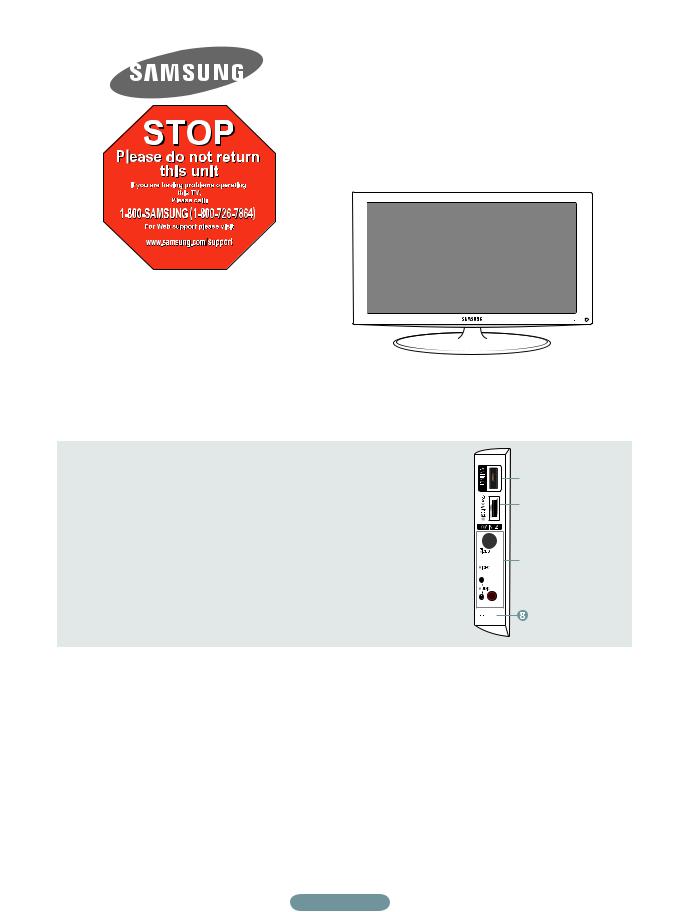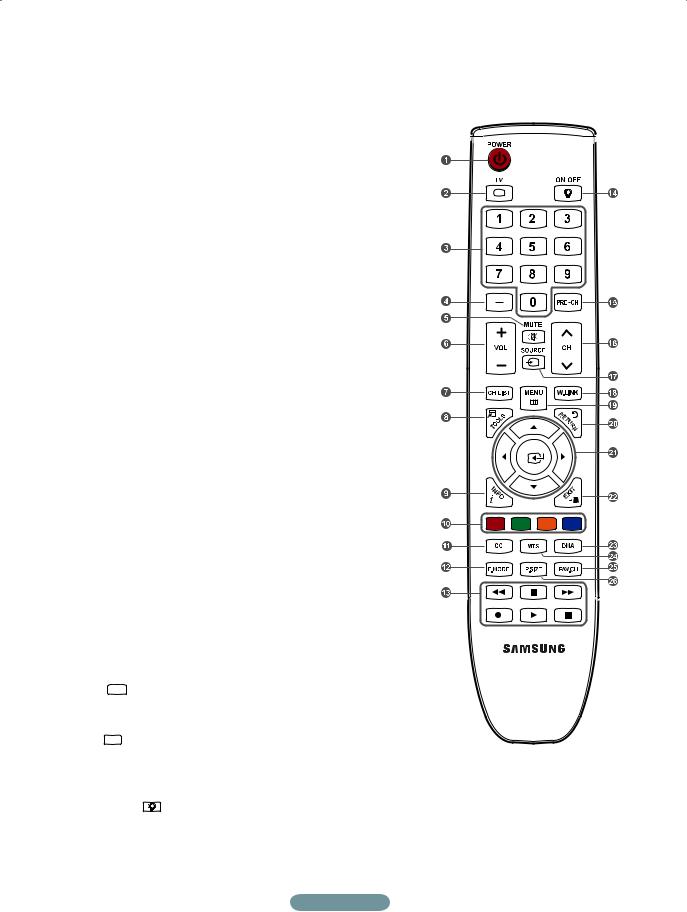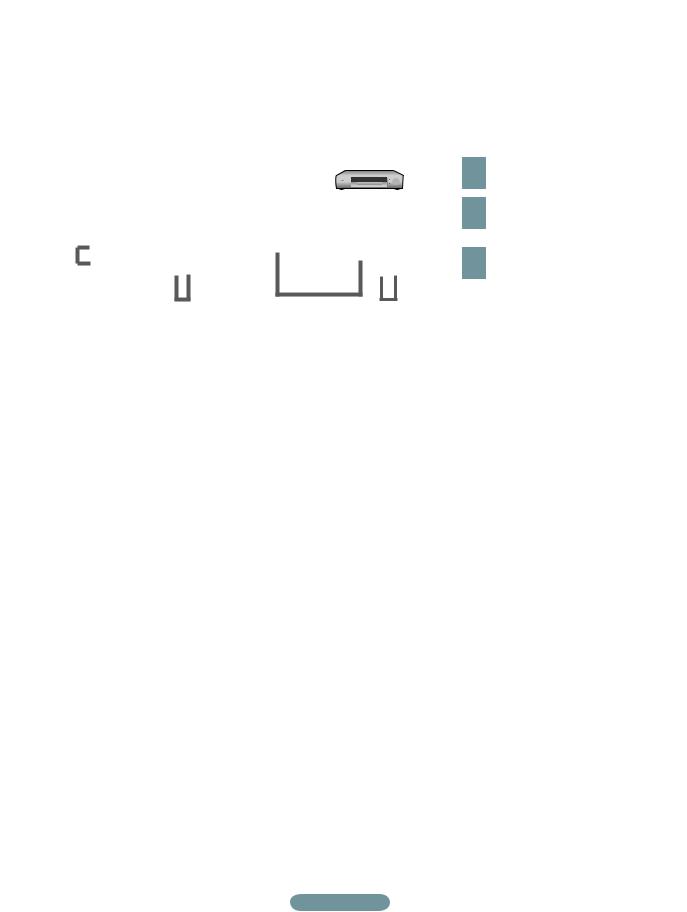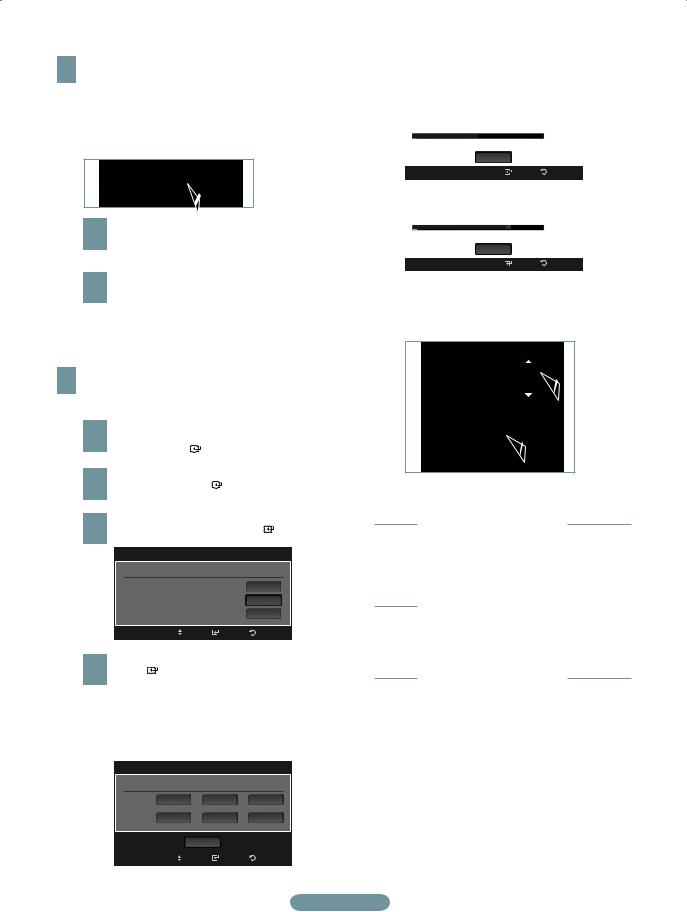SAMSUNG LN-52B530, LN-46B750, LN-46B650, LN-37B530, LN-40C650 User Manual
...
Quick Setup Guide
LN32A550P3F/LN37A550P3F/
LN40A550P3F/LN46A550P3F/
LN52A550P3F
1-800-SAMSUNG (7267864)
Samsung Electronics America, Inc.
105 Challenger Road Ridgefield Park, NJ 07660-0511
Samsung Electronics Canada Inc., Customer Service
55 Standish Court Mississauga, Ontario L5R 4B2
Call center hours of operation (Mon-Sun 9AM-12AM EST).
To register this product please visit www.samsung.com/global/register.
 Rear Panel / Side Panel Jacks
Rear Panel / Side Panel Jacks
1 AUDIO OUT |
5 ANT IN |
9 POWER INPUT |
|
2 DIGITAL AUDIO OUT (OPTICAL) |
6 WISELINK |
0 COMPONENT IN 1, 2 / AV IN 1 |
|
3 PC IN [PC] / [AUDIO] |
7 AV IN 2, S-VIDEO |
! EX-LINK |
|
4 HDMI IN 1, 2, 3 / DVI IN (HDMI2) |
8 |
HEADPHONE |
@ KENSINGTON LOCK |
[R-AUDIO-L] |
|
|
|
Video Input Performance Comparison |
|
|
Audio Output Performance Comparison |
|||||
/ |
HDMI/DVI |
Best |
|
|
|
|
OPTICAL (Digital) |
Best |
|
|
|
|
|||||
|
|
|
|
|||||
|
|
|
|
|||||
/ |
PC/COMPONENT |
Better |
|
|
|
|
AUDIO (Analog) |
Normal |
|
S-VIDEO |
Good |
|
|
|
|
|
|
|
VIDEO |
Normal |
|
|
|
|
|
|
|
|
|
English- |
|
||||

 Remote Control
Remote Control
See “Remote Control” in the owner’s instructions for details.
1POWER
Turns the TV on and off.
2TV
Selects the TV mode directly.
3NUMERIC BUTTONS
Press to change the channel.
4
Press to select additional channels (digital and analog) being broadcast by the same station. For example, to select channel “54-3”, press “54”, then press “ ” and “3”.
” and “3”.
5 (MUTE)
(MUTE)
Press to temporarily cut off the sound.
6VOL – / VOL +
Press to increase or decrease the volume.
7CH LIST
Used to display Channel Lists on the screen.
8TOOLS
Use to quickly select frequently used functions.
9INFO
Press to display information on the TV screen.
0COLOR BUTTONS
Use these buttons in the Channel list, WISELINK, etc.
!CC
Controls the caption decoder.
@E.MODE
Press to select the preset display and sound modes for sports, cinema and games.
#Use these buttons in the DMA, WISELINK and Anynet+ modes.
(  : This remote can be used to control recording on Samsung recorders with the Anynet+ feature)
: This remote can be used to control recording on Samsung recorders with the Anynet+ feature)
$  ON/OFF
ON/OFF
Press to backlight the buttons on the remote. This function is convenient for using at night or when the room is dark. (Using the remote control with the ON/OFF light button set to On will reduce the battery usage time.)
%PRE-CH
Tunes to the previous channel.
^CH  / CH
/ CH 
Press to change channels.
&SOURCE
Press to display and select the available video sources.
*W.LINK (WISELINK)
This function enables you to view and play photo and music files from an external device.
( MENU
Displays the main on-screen menu.
) RETURN
Returns to the previous menu.
aUP▲ / DOWN▼ / LEFT◄ / RIGHT► / ENTER 
Use to select on-screen menu items and change menu values.
bEXIT
Press to exit the menu.
cDMA (Digital Media Adapter)
Use this when connecting a SAMSUNG DMA device
through an HDMI interface and switching to DMA mode.
For more information on the operating procedures, refer to the user manual of the DMA.
This button is available when “Anynet+(HDMI-CEC)” is “On”.
dMTS
Press to choose stereo, mono or Separate Audio Program (SAP broadcast).
eFAV.CH
Press to switch to your favorite channels.
fP.SIZE
Picture size selection.
English-

 Connecting a DVD Player or Cable Box/Satellite receiver (Set-Top Box) via HDMI
Connecting a DVD Player or Cable Box/Satellite receiver (Set-Top Box) via HDMI
TV Side Panel
TV Rear Panel
1 |
Connect an HDMI Cable between |
the HDMI IN (1, 2 or 3) jack on |
|
the TV and the HDMI jack on the |
|
|
DVD Player or Cable Box/Satellite |
receiver (Set-Top Box).
What is HDMI?
•HDMI(High-Definition Multimedia Interface), is an interface that enables the transmission of digital audio and video signals using a single cable.
DVD Player or Cable Box/ Satellite receiver (Set-Top Box)
or |
1 HDMI Cable (Not supplied)
•The difference between HDMI and DVI is that the HDMI device is smaller in size and has the HDCP (High Bandwidth Digital Copy Protection) coding feature installed.
Each DVD Player or Cable Box/Satellite receiver (Set-Top Box) has a different back panel configuration.
The TV may not output sound and pictures may be displayed with abnormal color when DVD players/Cable Boxes/Satellite receivers supporting HDMI versions older than 1.3 are connected. When connecting an older HDMI cable and there is no sound, connect the HDMI cable to the HDMI IN 2 jack and the audio cables to the DVI IN (HDMI2) [R-AUDIO-L] jacks on the back of the TV. If this happens, contact the company that provided the DVD player/Cable Box/Satellite receiver to confirm the HDMI version, then request an upgrade.
HDMI cables that are not 1.3 may cause annoying flicker or no screen display.
 Connecting a DVD Player or Cable Box/Satellite receiver (Set-Top Box) via DVI
Connecting a DVD Player or Cable Box/Satellite receiver (Set-Top Box) via DVI
TV Rear Panel
DVD Player or Cable Box/
Satellite receiver (Set-Top Box)
|
|
1 |
Connect a DVI to HDMI Cable or |
|
DVI-HDMI Adapter between the |
||
|
|
|
HDMI IN 2 jack on the TV and the |
|
|
|
|
|
|
|
DVI jack on the DVD Player or Cable |
|
|
|
Box/Satellite receiver (Set-Top Box). |
|
|
|
|
2 |
Connect Audio Cables between the |
||
DVI IN (HDMI 2) [R-AUDIO-L] jack on |
|||
the TV and the DVD Player or Cable
Box/Satellite receiver (Set-Top Box).
2 Audio Cable (Not supplied)
1 DVI to HDMI Cable (Not supplied)
Each DVD Player or Cable Box/Satellite receiver (Set-Top Box) has a different back panel configuration.
When connecting a DVD Player or Cable Box/Satellite receiver (Set-Top Box), match the color of the connection terminal to the cable.
When using an HDMI/DVI cable connection, you must use the HDMI IN 2 jack.
English-

 Connecting a DVD Player or Cable Box/Satellite receiver (Set-Top Box) via Component cables
Connecting a DVD Player or Cable Box/Satellite receiver (Set-Top Box) via Component cables
TV Rear Panel
DVD Player or Cable Box /
Satellite receiver (Set-Top Box)
Connect a Component Cable between 1 the COMPONENT IN (1 or 2)
[Y, PB, PR] jacks on the TV and the COMPONENT [Y, PB, PR] jacks on the DVD Player or Cable Box/Satellite receiver (Set-Top Box).
Connect Audio Cables between the 2 COMPONENT IN(1 or 2) [R-AUDIO-L]
jacks on the TV and the AUDIO OUT jacks on the DVD Player or Cable Box/ Satellite receiver (Set-Top Box).
|
|
Component video separates the video |
|
|
|
into Y (Luminance (brightness)), Pb |
|
|
|
(Blue) and Pr (Red) for enhanced video |
|
|
|
quality. Be sure to match the component |
|
|
|
video and audio connections. |
|
|
|
For example, if connecting a Component |
|
1 |
Component Cable |
video cable to COMPONENT IN 1, |
|
connect the audio cable to |
|||
(Not supplied) |
|||
|
|
COMPONENT IN 1 also. |
|
2 Audio Cable (Not supplied) |
Each DVD Player or Cable Box/Satellite |
||
receiver (Set-Top Box) has a different |
|||
|
|
back panel configuration. |
|
|
|
When connecting a DVD Player or |
|
|
|
Cable Box/Satellite receiver (Set-Top |
|
|
|
Box), match the color of the connection |
|
|
|
terminal to the cable. |
|
 Connecting a Camcorder
Connecting a Camcorder
TV Side Panel
Camcoder |
1 |
S-Video cable (Not supplied) |
or |
||
|
1 |
Audio cable (Not supplied) |
|
2 |
Audio cable |
|
(Not supplied) |
Connect a Video Cable (or S-Video 1 Cable) between the AV IN2 [VIDEO] (or S-VIDEO) jack on the TV and the
VIDEO OUT jack on the camcorder.
Connect Audio Cables between the 2 AV IN2 [R-AUDIO-L] jacks on the TV
and the AUDIO OUT jacks on the camcorder.
Each Camcorder has a different back panel configuration.
When connecting a Camcorder, match the color of the connection terminal to the cable.
English-

 Connecting a VCR
Connecting a VCR
Video Connection
TV Side Panel |
TV Rear Panel |
|
Unplug the cable or antenna |
|
1 |
||
from the back of the TV. |
VCR Rear Panel |
2 |
|
|
|
3 |
Connect the cable or antenna to the ANT IN terminal on the back of the VCR.
Connect an RF Cable between the ANT OUT terminal on the VCR and the ANT IN terminal on the TV.
3 |
RF Cable |
(Not supplied) |
5 Audio Cable
(Not supplied)
4 Video Cable
(Not supplied)
Follow the instructions in “Viewing a VCR or Camcorder Tape” to view your VCR tape.
Connect a Video Cable
4 between the VIDEO OUT jack on the VCR and the AV IN 1 [Y/VIDEO] or AV IN 2 [VIDEO] jack on the TV.
Connect Audio Cables between 5 the AUDIO OUT jacks on the
VCR and the AV IN 1 (or AV IN 2) [R-AUDIO-L] jacks on the TV.
If you have a “mono” (non-stereo) VCR, use a Y-connector (not supplied) to connect to the right and left audio input jacks of the TV. Alternatively, connect the cable to the “R” jack. If your VCR is stereo, you must connect two cables.
Each VCR has a different back panel configuration.
When connecting a VCR, match the color of the connection terminal to the cable.
When connecting to AV NI 1, the color of the AV IN 1 [Y/VIDEO] jack (Green) does not match the color of the video cable (Yellow).
S-Video Connection
TV Side Panel |
TV Rear Panel |
VCR Rear Panel
To begin, follow steps 1–3 in 1 the previous section to connect
the antenna or cable to your VCR and your TV.
|
|
2 |
Connect an S-Video Cable |
|
|
between the S-VIDEO OUT jack |
|
|
|
on the VCR and the AV IN 2 |
|
|
|
|
[S-VIDEO] jack on the TV. |
|
|
3 |
Connect Audio Cables between |
|
|
the AUDIO OUT jacks on the VCR |
|
|
|
|
and the AV IN 2 [R-AUDIO-L] |
|
|
|
jacks on the TV. |
|
|
An S-Video cable may be included |
|
1 |
RF Cable |
with a VCR. (If not, check your local |
|
(Not supplied) |
electronics store.) |
||
|
S-Video Cable |
Each VCR has a different back |
|
2 |
|
panel configuration. |
|
(Not supplied) |
|
||
|
|
When connecting a VCR, match |
|
3 |
Audio Cable |
|
the color of the connection |
|
terminal to the cable. |
||
(Not supplied) |
|
||
English-

 Connecting a Digital Audio System
Connecting a Digital Audio System
TV Rear Panel
Digital Audio System
1 Optical Cable (Not supplied)
Connect an Optical Cable between 1 the “DIGITAL AUDIO OUT
(OPTICAL)” jacks on the TV and the Digital Audio Input jacks on the Digital Audio System.
When a Digital Audio System is connected to the “DIGITAL AUDIO OUT (OPTICAL)” jack: Decrease the volume of the TV and adjust the volume level with the system’s volume control.
5.1CH audio is possible when the TV is connected to an external device supporting 5.1CH.
Each Digital Audio System has a different back panel configuration.
When the receiver (home theater) is set to On, you can hear sound output from the TV’s Optical jack. When the TV is displaying a DTV(air) signal, the TV will send out 5.1 channel sound to the Home theater receiver. When the source is a digital component such as a DVD and is connected to the TV via HDMI, only 2 channel sound will be heard from the Home Theater receiver. If you want to hear 5.1 channel audio, connect the DIGITAL AUDIO OUT (OPTICAL) jack on the DVD player
or Cable/Satellite Box directly to an Amplifier or Home Theater, not the TV.
 Connecting an Amplifier/DVD Home Theater
Connecting an Amplifier/DVD Home Theater
TV Rear Panel
Amplifier/DVD Home Theater
1 Audio Cable (Not supplied)
Connect Audio Cables between the 1 AUDIO OUT [R-AUDIO-L] jacks on the TV and AUDIO IN [R-AUDIO-L]
jacks on the Amplifier/DVD Home Theater.
When an audio amplifier is connected to the “AUDIO OUT [R-AUDIO-L]” jack: Decrease the volume of the TV and adjust the volume level with the Amplifier’s volume control.
Each Amplifier/DVD Home Theater has a different back panel configuration.
When connecting an Amplifier/DVD Home Theater, match the color of the connection terminal to the cable.
English-

 Connecting a PC
Connecting a PC
Using the D-Sub Cable
TV Rear Panel
PC
D-Sub Cable 1 (Not supplied)
2 PC Audio Cable
(Not supplied)
Using the HDMI/DVI Cable
TV Rear Panel
PC
HDMI/DVI Cable 1 (Not supplied)
2 3.5 mm Stereo mini-plug/ 2RCA Cable (Not supplied)
Using the D-Sub Cable
Connect a D-Sub Cable between 1 PC IN [PC] connector on the TV and
the PC output connector on your computer.
Connect a PC Audio Cable between 2 the PC IN [AUDIO] jack on the TV
and the Audio Out jack of the sound card on your computer.
Using the HDMI/DVI Cable
Connect an HDMI/DVI cable between 1 the HDMI IN 2 jack on the TV and
the PC output jack on your computer.
Connect a 3.5 mm Stereo mini- 2 plug/2RCA Cable between the DVI
IN(HDMI2) [R-AUDIO-L] jack on the TV and the Audio Out jack of the sound card on your computer.
Each PC has a different back panel configuration.
When connecting a PC, match the color of the connection terminal to the cable.
When using an HDMI/DVI cable connection, you must use the HDMI IN 2 terminal.
English-

Turning the TV On and Off
Press the POWER button on the remote control. You can also use the POWER
button on the remote control. You can also use the POWER button on the TV.
button on the TV.
 Viewing the Menus
Viewing the Menus
With the power on, press the MENU button. 1 The main menu appears on the screen.
The menu’s left side has icons: Picture, Sound, Channel, Setup, Input, Application.
Press the ▲ or ▼ button to select one of the icons.
2 Then press the ENTER button to access the icon’s sub-menu. Press the EXIT button to exit.
button to access the icon’s sub-menu. Press the EXIT button to exit.
The on-screen menus disappear from the screen after about one minute.
Storing Channels in Memory
(Automatic Method)
1 |
Press the MENU button to display the menu. |
||
Press the ▲ or ▼ button to select “Channel”, then |
|||
|
press the ENTER button. |
|
|
2 |
Press the ▲ or ▼ button to select “Auto Program”, |
||
then press the ENTER |
button. |
|
|
3 |
Press the ▲ or ▼ button to select the antenna |
||
connection, then press the ENTER button. |
|||
|
Auto Program |
|
|
|
Select the Antenna source to memorize. |
|
|
|
Air |
|
Start |
|
Cable |
|
Start |
|
Auto |
|
Start |
|
Move |
Enter |
Return |
4 |
When selecting the Cable TV system: Press the |
||
ENTER button to start the auto program. |
|||
Press the ▲,▼, ◄ or ► to select the correct analog signal cable system source among “STD”, “HRC”, and “IRC”. Press the ▲ or ▼ button to select “Start”, then press the ENTER button. If you have Digital cable TV, select the cable system signal source for both Analog and Digital.
button. If you have Digital cable TV, select the cable system signal source for both Analog and Digital.
Auto Program
Selects the cable system.
Analog |
STD |
HRC |
IRC |
Digital |
STD |
HRC |
IRC |
|
Start |
|
|
|
Move |
Enter |
Return |
|
The TV begins memorizing all available stations. |
||||||
5 |
|||||||
Press the EXIT button to exit. |
|
|
|||||
|
|
|
|
|
|
||
|
|
|
Auto Program |
|
|
||
|
|
Auto Program in Progress. |
|
|
|
||
|
|
DTV Cable : 12 |
Cable : 32 |
|
Cable 38 |
|
|
|
|
|
|
|
50% |
|
|
|
|
|
|
|
|
|
|
|
|
|
Stop |
|
|
|
|
|
|
|
|
|
|
|
|
|
|
|
|
Enter |
Return |
||
|
|
|
|
|
|
||
|
|
|
Auto Program |
|
|
||
|
|
Removing scrambled channel. |
|
|
|
||
|
|
DTV Cable : 16 |
Cable : 45 |
DTV Cable 41 |
|
||
|
|
|
|
|
77% |
|
|
|
|
|
|
|
|
|
|
|
|
|
Stop |
|
|
|
|
|
|
|
|
|
|
|
|
|
|
|
|
Enter |
Return |
||
After all the available channels are stored, it starts to remove scrambled channels.
The Auto program menu then reappears.
 To Stop the Auto Program Function
To Stop the Auto Program Function
Press the MENU button while the Auto Program function is being executed. You can also press the ENTER button to stop the setup.
button to stop the setup.
 Checking to see if Channels were Stored in Memory
Checking to see if Channels were Stored in Memory
Press the CH button. Only the channels stored in memory will be selected (in order).
 Selecting the antennas
Selecting the antennas
•Air: “Air” antenna signal.
•Cable: “Cable” antenna signal.
•Auto: “Air” and “Cable” antenna signals.
English-
